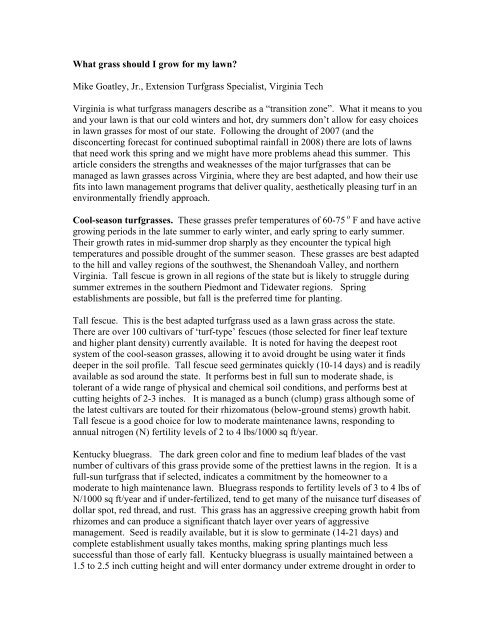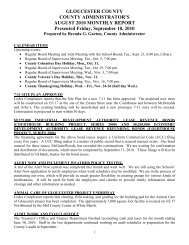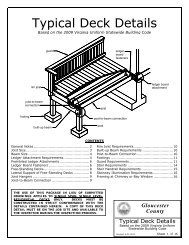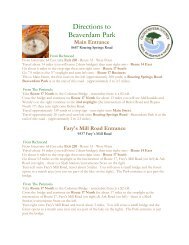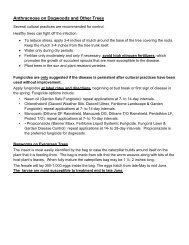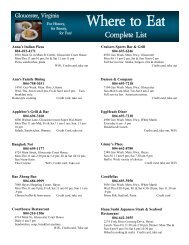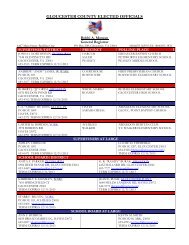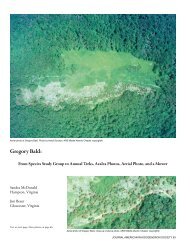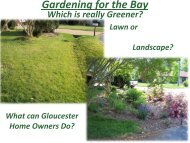What Grass Should I Plant? - Gloucester County Virginia
What Grass Should I Plant? - Gloucester County Virginia
What Grass Should I Plant? - Gloucester County Virginia
You also want an ePaper? Increase the reach of your titles
YUMPU automatically turns print PDFs into web optimized ePapers that Google loves.
<strong>What</strong> grass should I grow for my lawn?Mike Goatley, Jr., Extension Turfgrass Specialist, <strong>Virginia</strong> Tech<strong>Virginia</strong> is what turfgrass managers describe as a “transition zone”. <strong>What</strong> it means to youand your lawn is that our cold winters and hot, dry summers don’t allow for easy choicesin lawn grasses for most of our state. Following the drought of 2007 (and thedisconcerting forecast for continued suboptimal rainfall in 2008) there are lots of lawnsthat need work this spring and we might have more problems ahead this summer. Thisarticle considers the strengths and weaknesses of the major turfgrasses that can bemanaged as lawn grasses across <strong>Virginia</strong>, where they are best adapted, and how their usefits into lawn management programs that deliver quality, aesthetically pleasing turf in anenvironmentally friendly approach.Cool-season turfgrasses. These grasses prefer temperatures of 60-75 o F and have activegrowing periods in the late summer to early winter, and early spring to early summer.Their growth rates in mid-summer drop sharply as they encounter the typical hightemperatures and possible drought of the summer season. These grasses are best adaptedto the hill and valley regions of the southwest, the Shenandoah Valley, and northern<strong>Virginia</strong>. Tall fescue is grown in all regions of the state but is likely to struggle duringsummer extremes in the southern Piedmont and Tidewater regions. Springestablishments are possible, but fall is the preferred time for planting.Tall fescue. This is the best adapted turfgrass used as a lawn grass across the state.There are over 100 cultivars of ‘turf-type’ fescues (those selected for finer leaf textureand higher plant density) currently available. It is noted for having the deepest rootsystem of the cool-season grasses, allowing it to avoid drought be using water it findsdeeper in the soil profile. Tall fescue seed germinates quickly (10-14 days) and is readilyavailable as sod around the state. It performs best in full sun to moderate shade, istolerant of a wide range of physical and chemical soil conditions, and performs best atcutting heights of 2-3 inches. It is managed as a bunch (clump) grass although some ofthe latest cultivars are touted for their rhizomatous (below-ground stems) growth habit.Tall fescue is a good choice for low to moderate maintenance lawns, responding toannual nitrogen (N) fertility levels of 2 to 4 lbs/1000 sq ft/year.Kentucky bluegrass. The dark green color and fine to medium leaf blades of the vastnumber of cultivars of this grass provide some of the prettiest lawns in the region. It is afull-sun turfgrass that if selected, indicates a commitment by the homeowner to amoderate to high maintenance lawn. Bluegrass responds to fertility levels of 3 to 4 lbs ofN/1000 sq ft/year and if under-fertilized, tend to get many of the nuisance turf diseases ofdollar spot, red thread, and rust. This grass has an aggressive creeping growth habit fromrhizomes and can produce a significant thatch layer over years of aggressivemanagement. Seed is readily available, but it is slow to germinate (14-21 days) andcomplete establishment usually takes months, making spring plantings much lesssuccessful than those of early fall. Kentucky bluegrass is usually maintained between a1.5 to 2.5 inch cutting height and will enter dormancy under extreme drought in order to
survive. The newest releases of bluegrasses to hit the market are the “hybridbluegrasses”, crosses of Kentucky and Texas bluegrass. These grasses tout better heatand drought tolerance. To date, they look promising for the warmer, drier regions of<strong>Virginia</strong> but have not distinguished themselves from standard Kentucky bluegrasses inthe cooler regions. Sod is not as widely available for bluegrass as tall fescue, but thereare producers of bluegrass-only sod in the state. Mixtures of bluegrass and tall fescueare popular in sod production, providing advantages in pest and environmental stresstolerance while maintaining a uniform appearance.Fine-leaf fescues. This group of extremely fine-bladed grasses are some of the mostunder-utilized grasses in the state, being well adapted to the Valley and Ridge andnorthern Piedmont regions. People either love or hate fine fescues because of theirneedle-like leaf texture. However, these grasses (broken down into species such ascreeping red, hard, or chewings fescues) provide some of the highest quality, lowmaintenance cool-season turf possible. They are ideal for low maintenance lawns whereminimal fertility and fewer mowing events are desired, but fine fescues have poor traffictolerance, so be wary of using them if your lawn will have lots of use from kids or pets.The fine fescues have the best shade tolerance of the cool-season turfgrasses and are verypersistent in dry conditions and somewhat poor soils. They generally do not fare well inpersistently wet soils and their quality will decline if over fertilized (only 1 to 2 lbsN/1000 sq ft/year is recommended). Seed is readily available but there are not nearly asmany choices in cultivars as for other species. Fine fescue seed germinates pretty quickly(10-14 days) but is a somewhat slow establisher, so fall seedings are best. It thrivesunder mowing heights of 1.5 to 2.5 inches, but is often used in the mountains as ‘nomow’ turf for areas too steep to mow. Seed mixtures with Kentucky bluegrass arecommonly sold as ‘sun-shade’ mixes where bluegrass is intended to dominate in the sunand fine fescue in the shade. The grasses likely will segregate out over time, but finefescue has the best chance of persisting in moderate shade. There are no fine fescue sodproducers in the region.Perennial ryegrass. This grass fell out of favor for homelawn use in the 1990s when grayleaf spot disease ravaged many ryegrass cultivars on the east coast. However, turfbreeders have since selected for greatly improved resistance to gray leaf spot andperennial ryegrass has returned to a place of prominence in <strong>Virginia</strong>’s cooler climates.Perennial ryegrass is a bunch-type grass best suited for use in full sun to moderatelyshaded lawns at elevations above 1500 feet. It is one of the fastest germinating grassesfrom seed (7-10 days) and also one of the fastest to establish a dense canopy. Matureperennial ryegrass has excellent wear tolerance but it is not very heat and droughttolerant, and can have significant disease pressure in warmer climates. It tolerates someof the lowest mowing heights possible (1 to 2.5 inch recommended cutting height) and isnoted for its striping potential when mowed. Ryegrass responds to 2 to 4 lbs N/1000 sqft/year, with higher rates being used when it is mixed with Kentucky bluegrass at 80-90%ryegrass by seed weight. This seed combination takes advantage of the rapidestablishment characteristics of the ryegrass and the long-term creeping potential of thebluegrass. There is no perennial ryegrass sod produced in the state.
Warm-season grasses. These grasses prefer temperatures of 80-95 o F and will have awinter dormancy period (i.e. loss of green color) of 3-5 months depending on where theyare used in the state. As a group, these grasses have fewer pest problems, greater wateruse efficiency rates, and less sensitivity to environmental extremes of summer.Zoysiagrass and bermudagrass are adapted for lawns across the state although onlyzoysiagrass typically might be grown in the cooler climates. Centipedegrass and St.Augustinegrass are adapted only to the Tidewater region. The ideal time to establishwarm-season grasses is mid-May through June around the state.Bermudagrass. This grass is considered as both an awesome turfgrass and one of theworld’s most troublesome weeds. Bermudagrass is the fastest growing turfgrass used onlawns, creeping by both stolons (aboveground stems) and rhizomes. Hence it canbecome a serious invasive pest in gardens and plant beds but has tremendous recuperativepotential if damaged. It is a full-sun grass with very poor shade tolerance that toleratesmowing heights from 0.5 to 2.5 inches (cutting less than 1” requires a reel mower ratherthan a standard rotary unit). Many superior cultivars can only be established vegetativelyby sod, sprigs (i.e. stems), or plugs, but several improved varieties established from seedare now available. While not known for its cold tolerance, recent releases selected withcold-tolerance in mind have broadened the use of bermudagrass all across the state.Bermudagrass responds well to 2 to 4 lbs of N/1000 sq ft/season, and higher levels ofmanagement will likely result in a grass that needs periodic vertical mowing for thatchcontrol. There are several producers of bermudagrass sod around the state.Zoysiagrass. This warm-season grass is the most cold-hardy of the group and is veryunlikely to be damaged by even a severe winter in this region. While zoysia spreads byboth rhizomes and stolons, it is an extremely slow grower as compared to bermudagrass,this presents a challenge while waiting for it to establish (either vegetatively or fromrecently available seeded cultivars), but upon gaining full establishment, it is a very lowmaintenance grass with lower mowing frequencies. It is noted for its exceptional density,such that its density often provides its own weed control. It has few pest problems andwhile not as drought tolerant as bermudagrass, it still exceeds the cool-season grasses interms of water use efficiency. It has average shade tolerance and tolerates mowingheights of 1 to 2.5 inches. Optimal fertility programs for zoysia are 1 to 2 lbs N/1000 sqft/season and under these levels of fertility, it is not likely to produce significant thatch.Zoysiagrass requires a very sharp mower blade to provide a high quality cut. It isexpensive to establish because of its slow growth rate, but end users are ultimatelyrewarded for their patience or cash outlay with one of the highest quality, lowmaintenance turfgrasses available. There are a small number of zoysiagrass sodproducers around <strong>Virginia</strong>.Centipedegrass. This slow growing, stoloniferous grass is only adapted to the Tidewaterregion. It is commonly referred to as the “poor folks grass of the south”. Seed isavailable for centipedegrass and while there are no sod producers in the state, there arenumerous producers in eastern North Carolina that serve the VA market. Centipede has anaturally yellow-green color and is an extremely slow growing grass with average shadetolerance and tolerance to acid soil conditions. To improve its color, it is common for
lawn service companies to use liquid iron fertilizers to enhance the greening without a lotof foliar growth. It prefers cutting heights of 1.5 to 2.5 inches and thrives under lowmaintenance programs providing only 1 to 2 lbs N/1000 sq ft per year. It has few pestproblems and one of its biggest weaknesses is its poor traffic tolerance. Mostcentipedegrass sod comes to <strong>Virginia</strong> from the Carolinas and seed is available, but isquite expensive.St. Augustinegrass. This tropical origin, fast growing, stoloniferous grass is also onlyadapted to the Tidewater region. St. Augustine’s biggest advantage as a warm-seasongrass comes from its excellent shade tolerance. Establishment is almost exclusively bysod or plugs from farms south of <strong>Virginia</strong>. It forms a high density, rapidly spreading turfthat usually has more problems with insects and diseases than other warm-season grasses.It prefers mowing heights of 2-3 inches and responds to N fertility programs of 2 to 4lbs/1000 sq ft/year. As a species, it is noted for poor cold tolerance, but there are lawnsin the Tidewater region that have never encountered serious winter kill due to winterextremes. Seed is very difficult to locate and the majority of St. Augustinegrass isestablished vegetatively (sod or plugs) from material imported into the state from theCarolinas and south.Where can I get more information? Your local <strong>Virginia</strong> Cooperative Extension officecan assist you in selecting varieties of these grasses that best fit your needs. The <strong>Virginia</strong>Turfgrass Variety Recommendation list and list of <strong>Virginia</strong> sod producers can be foundunder the lawn and landscape link at the VCE website, www.ext.vt.edu/.


